Pioneer VSX-521-K User Manual
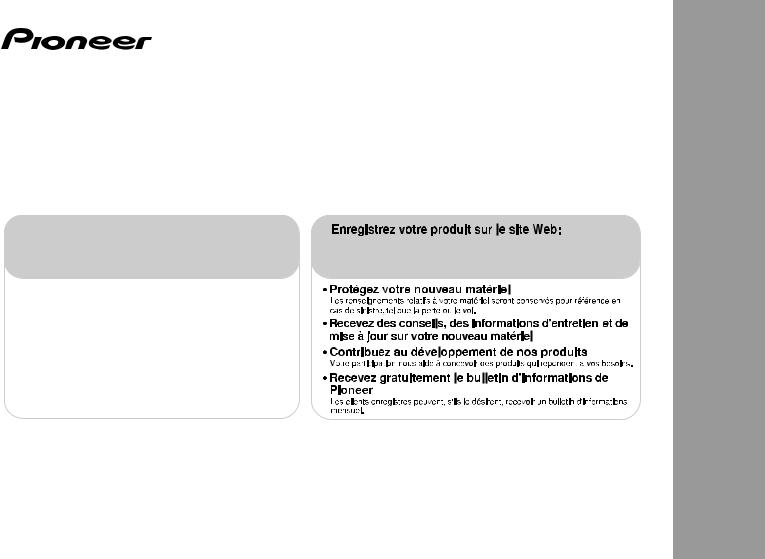
AUDIO/VIDEO MULTI-CHANNEL RECEIVER RECEPTEUR AUDIOVISUEL A VOIES MULTI-CANAUX RECEPTOR AUDIO-VIDEO MULTICANAL
VSX-521-K
Register your product on |
|
http://www.pioneerelectronics.com (US) |
http://www.pioneerelectronics.com (US) |
http://www.pioneerelectronics.ca (Canada) |
http://www.pioneerelectronics.ca (Canada) |
• Protect your new investment
The details of your purchase will be on file for reference in the event of an insurance claim such as loss or theft.
• Receive free tips, updates and service bulletins on your new product
• Improve product development
Your input helps us continue to design products that meet your needs.
• Receive a free Pioneer newsletter
Registered customers can opt in to receive a monthly newsletter.
Operating Instructions Mode d’emploi
Manual de instrucciones
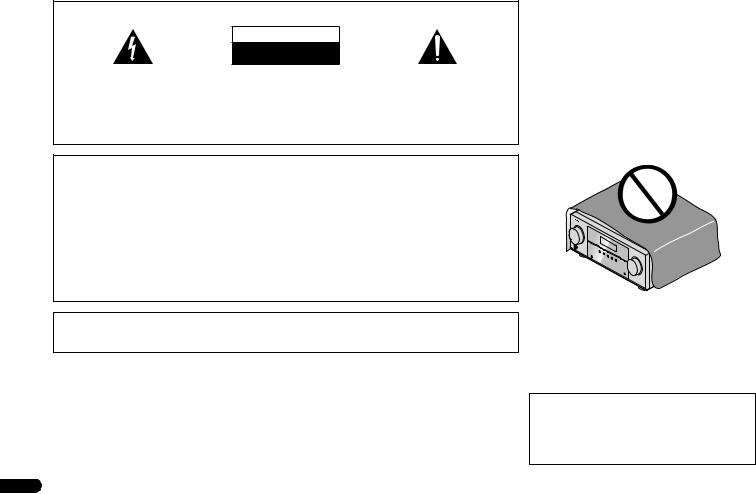
IMPORTANT
The lightning flash with arrowhead symbol, within an equilateral triangle, is intended to alert the user to the presence of uninsulated “dangerous voltage” within the product’s enclosure that may be of sufficient magnitude to constitute a risk of electric shock to persons.
CAUTION
RISK OF ELECTRIC SHOCK
DO NOT OPEN
CAUTION:
TO PREVENT THE RISK OF ELECTRIC SHOCK, DO NOT REMOVE COVER (OR BACK). NO USER-SERVICEABLE PARTS INSIDE. REFER SERVICING TO QUALIFIED SERVICE PERSONNEL.
The exclamation point within an equilateral triangle is intended to alert the user to the presence of important operating and maintenance (servicing) instructions in the literature accompanying the appliance.
D3 4 2 1 1_A1_En
NOTE:
This equipment has been tested and found to comply with the limits for a Class B digital device, pursuant to Part 15 of the FCC Rules. These limits are designed to provide reasonable protection against harmful interference in a residential installation. This equipment generates, uses, and can radiate radio frequency energy and, if not installed and used in accordance with the instructions, may cause harmful interference to radio communications. However, there is no guarantee that interference will not occur in a particular installation. If this equipment does cause harmful interference to radio or television reception, which can be determined by turning the equipment off and on, the user is encouraged to try to correct the interference by one or more of the following measures:
Reorient or relocate the receiving antenna.
Increase the separation between the equipment and receiver.
Connect the equipment into an outlet on a circuit different from that to which the receiver is connected. Consult the dealer or an experienced radio/TV technician for help.
D8 10 1 2_A1_En
Information to User
Alterations or modifications carried out without appropriate authorization may invalidate the user’s right to operate the equipment.
WARNING
This equipment is not waterproof. To prevent a fire or shock hazard, do not place any container filled with liquid near this equipment (such as a vase or flower pot) or expose it to dripping, splashing, rain or moisture.
WARNING
To prevent a fire hazard, do not place any naked flame sources (such as a lighted candle) on the equipment.
D3 4 2 1 7a_A1_En
2
WARNING
Before plugging in for the first time, read the following section carefully.
The voltage of the available power supply differs according to country or region. Be sure that the power supply voltage of the area where this unit will be used meets the required voltage (e.g., 230 V or 120 V) written on the rear panel.
D3 4 2 1 4*_A1_En
VENTILATION CAUTION
When installing this unit, make sure to leave space around the unit for ventilation to improve heat radiation (at least 40 cm at top, 20 cm at rear, and 20 cm at each side).
WARNING
Slots and openings in the cabinet are provided for ventilation to ensure reliable operation of the product, and to protect it from overheating. To prevent fire hazard, the openings should never be blocked or covered with items (such as newspapers, table cloths, curtains) or by operating the equipment on thick carpet or a bed.
D3 4 2 1 7b*_A1_En
Operating Environment
Operating environment temperature and humidity: +5 °C to +35 °C (+41 °F to +95 °F); less than 85 %RH (cooling vents not blocked)
Do not install this unit in a poorly ventilated area, or in locations exposed to high humidity or direct sunlight (or strong artificial light)
Caution
To prevent fire hazard, the Class 2 Wiring Cable should be used for connection with speaker, and should be routed away from hazards to avoid damage to the insulation of the cable.
D3 7 13 67*_A1_En
En

1)Read these instructions.
2)Keep these instructions.
3)Heed all warnings.
4)Follow all instructions.
5)Do not use this apparatus near water.
6)Clean only with dry cloth.
7)Do not block any ventilation openings. Install in accordance with the manufacturer’s instructions.
8)Do not install near any heat sources such as radiators, heat registers, stoves, or other apparatus (including amplifiers) that produce heat.
9)Do not defeat the safety purpose of the polarized or grounding-type plug. A polarized plug has two blades with one wider than the other. A grounding type plug has two blades and a third grounding prong. The wide blade or the third prong are provided for your safety. If the provided plug does not fit into your outlet, consult an electrician for replacement of the obsolete outlet.
10)Protect the power cord from being walked on or pinched particularly at plugs, convenience receptacles, and the point where they exit from the apparatus.
11)Only use attachments/accessories specified by the manufacturer.
12)Use only with the cart, stand, tripod, bracket, or table specified by the manufacturer, or sold with the apparatus. When a cart is used, use caution when moving the cart/apparatus combination to avoid injury from tip-over.
13)Unplug this apparatus during lightning storms or when unused for long periods of time.
14)Refer all servicing to qualified service personnel. Servicing is required when the apparatus has been damaged in any way, such as power-supply cord or plug is damaged, liquid has been spilled or objects have fallen into the apparatus, the apparatus has been exposed to rain or moisture, does not operate normally, or has been dropped.
D3-7-13-69_En
If the AC plug of this unit does not match the AC outlet you want to use, the plug must be removed and appropriate one fitted. Replacement and mounting of an AC plug on the power supply cord of this unit should be performed only by qualified service personnel. If connected to an AC outlet, the cut off plug can cause severe electrical shock. Make sure it is properly disposed of after removal.
The equipment should be disconnected by removing the mains plug from the wall socket when left unused for a long period of time (for example, when on vacation).
D3 4 2 2 1a_A1_En
CAUTION
The STANDBY/ON switch on this unit will not completely shut off all power from the AC outlet. Since the power cord serves as the main disconnect device for the unit, you will need to unplug it from the AC outlet to shut down all power. Therefore, make sure the unit has been installed so that the power cord can be easily unplugged from the AC outlet in case of an accident. To avoid fire hazard, the power cord should also be unplugged from the AC outlet when left unused for a long period of time (for example, when on vacation).
STANDBY/ON switch on this unit will not completely shut off all power from the AC outlet. Since the power cord serves as the main disconnect device for the unit, you will need to unplug it from the AC outlet to shut down all power. Therefore, make sure the unit has been installed so that the power cord can be easily unplugged from the AC outlet in case of an accident. To avoid fire hazard, the power cord should also be unplugged from the AC outlet when left unused for a long period of time (for example, when on vacation).
D3 4 2 2 2a*_A1_En
This Class B digital apparatus complies with Canadian ICES 003.
CAUTION
This product satisfies FCC regulations when shielded cables and connectors are used to connect the unit to other equipment. To prevent electromagnetic interference with electric appliances such as radios and televisions, use shielded cables and connectors for connections.
IMPORTANT NOTICE
THE MODEL NUMBER AND SERIAL NUMBER OF THIS EQUIPMENT ARE ON THE REAR OR BOTTOM. RECORD THESE NUMBERS ON YOUR ENCLOSED WARRANTY CARD AND KEEP IN A SAFE PLACE FOR FUTURE REFERENCE.
D36 AP9 1_A1_En
WARNING: Handling the cord on this product or cords associated with accessories sold with the product may expose you to chemicals listed on proposition 65 known to the State of California and other governmental entities to cause cancer and birth defect or other reproductive harm.
D36 P5_B1_En
This product is for general household purposes. Any failure due to use for other than household purposes (such as long term use for business purposes in a restaurant or use in a car or ship) and which requires repair will be charged for even during the warranty period.
(Symbol examples for batteries)
These symbols are only valid in the European Union.
Pb |
K058c_A1_En |
English
3
En

Thank you for buying this Pioneer product. Please read through these operating instructions so you will know how to operate your model properly. After you have finished reading the instructions, put them away in a safe place for future reference.
Contents
Before you start . . . . . . . . . . . . . . . . . . . . . . . . . . . . 5
Checking what’s in the box . . . . . . . . . . . . . . . . . . . . . . . . 5 Installing the receiver . . . . . . . . . . . . . . . . . . . . . . . . . . . . 5
Flow of settings on the receiver. . . . . . . . . . . . . . 5
01 Controls and displays
Front panel . . . . . . . . . . . . . . . . . . . . . . . . . . . . . . . . . . . . 6 Display . . . . . . . . . . . . . . . . . . . . . . . . . . . . . . . . . . . . . . 7 Remote control . . . . . . . . . . . . . . . . . . . . . . . . . . . . . . . . . 8 Loading the batteries . . . . . . . . . . . . . . . . . . . . . . . . . . . 9
Operating range of remote control . . . . . . . . . . . . . . . . . 9
02 Connecting your equipment
Placing the speakers . . . . . . . . . . . . . . . . . . . . . . . . . . . . 10
Hints on the speaker placement. . . . . . . . . . . . . . . . . . 10
Connecting the speakers. . . . . . . . . . . . . . . . . . . . . . . . . 11
Connect the surround back or front height speakers . . 11
Making cable connections . . . . . . . . . . . . . . . . . . . . . . . 12 HDMI cables . . . . . . . . . . . . . . . . . . . . . . . . . . . . . . . . 12 About HDMI. . . . . . . . . . . . . . . . . . . . . . . . . . . . . . . . . 12 Analog audio cables. . . . . . . . . . . . . . . . . . . . . . . . . . . 13 Digital audio cables . . . . . . . . . . . . . . . . . . . . . . . . . . . 13 Video cables. . . . . . . . . . . . . . . . . . . . . . . . . . . . . . . . . 13
About video outputs connection . . . . . . . . . . . . . . . . . . . 13 Connecting a TV and playback components . . . . . . . . . . 14
Connecting using HDMI . . . . . . . . . . . . . . . . . . . . . . . 14
Connecting your component with no HDMI terminal . . 15 Connecting a satellite receiver or other digital
set-top box. . . . . . . . . . . . . . . . . . . . . . . . . . . . . . . . . . . . 15
Connecting an HDD/DVD recorder, Blu-ray Disc
recorder and other video sources . . . . . . . . . . . . . . . . . . 16 Using the component video jacks . . . . . . . . . . . . . . . . . . 16 Connecting other audio components . . . . . . . . . . . . . . . 17 Connecting optional Bluetooth® ADAPTER . . . . . . . . . . . 17
Connecting antennas . . . . . . . . . . . . . . . . . . . . . . . . . . . 17 Using external antennas . . . . . . . . . . . . . . . . . . . . . . . 18
Connecting to the front panel audio mini jack. . . . . . . . . 18
Plugging in the receiver . . . . . . . . . . . . . . . . . . . . . . . . . 18
03 Basic Setup
Canceling the demo display . . . . . . . . . . . . . . . . . . . . . . 19
Automatically setting up for surround sound (MCACC). . . 19 Other problems when using the Auto MCACC setup . . . 20
04 Basic playback
Playing a source . . . . . . . . . . . . . . . . . . . . . . . . . . . . . . . 21
Selecting the audio input signal . . . . . . . . . . . . . . . . . 21 Bluetooth® ADAPTER for Wireless Enjoyment
of Music . . . . . . . . . . . . . . . . . . . . . . . . . . . . . . . . . . . . . 22 Wireless music play . . . . . . . . . . . . . . . . . . . . . . . . . . 22
Pairing the Bluetooth ADAPTER and Bluetooth
wireless technology device . . . . . . . . . . . . . . . . . . . . . 23 Listening to Music Contents of Bluetooth wireless technology device with Your System . . . . . . . . . . . . . . 23
Listening to the radio . . . . . . . . . . . . . . . . . . . . . . . . . . . 24 Improving FM sound . . . . . . . . . . . . . . . . . . . . . . . . . . 24 Saving station presets . . . . . . . . . . . . . . . . . . . . . . . . . 24
Listening to station presets . . . . . . . . . . . . . . . . . . . . . 24
Naming preset stations . . . . . . . . . . . . . . . . . . . . . . . . 24
05 Listening to your system
Choosing the listening mode . . . . . . . . . . . . . . . . . . . . . 25
Auto playback . . . . . . . . . . . . . . . . . . . . . . . . . . . . . . . 25
Listening in surround sound . . . . . . . . . . . . . . . . . . . . 25 Using the Advanced surround . . . . . . . . . . . . . . . . . . 26
Using Stream Direct . . . . . . . . . . . . . . . . . . . . . . . . . . 26 Using the Sound Retriever . . . . . . . . . . . . . . . . . . . . . . . 26
Listening with Acoustic Calibration EQ. . . . . . . . . . . . . . 26 Better sound using Phase Control . . . . . . . . . . . . . . . . . 27 Using surround back channel processing . . . . . . . . . . . 27
Setting the Up Mix function . . . . . . . . . . . . . . . . . . . . . . 27 Setting the Audio options . . . . . . . . . . . . . . . . . . . . . . . . 28
Making an audio or a video recording. . . . . . . . . . . . . . . 29
06 The System Setup menu
Using the System Setup menu . . . . . . . . . . . . . . . . . . . . 30
Manual speaker setup . . . . . . . . . . . . . . . . . . . . . . . . . . 30 Speaker Setting . . . . . . . . . . . . . . . . . . . . . . . . . . . . . . 30 Crossover Network . . . . . . . . . . . . . . . . . . . . . . . . . . . 31 Channel Level . . . . . . . . . . . . . . . . . . . . . . . . . . . . . . . 31 Speaker Distance . . . . . . . . . . . . . . . . . . . . . . . . . . . . 32
The Input Assign menu. . . . . . . . . . . . . . . . . . . . . . . . . . 32 The Pre Out Setting . . . . . . . . . . . . . . . . . . . . . . . . . . . . 33 The Auto Power Down menu . . . . . . . . . . . . . . . . . . . . . 33
The FL Demo Mode menu . . . . . . . . . . . . . . . . . . . . . . . 33
07 Control with HDMI function
Making Control with HDMI connections . . . . . . . . . . . . 34
HDMI Setup . . . . . . . . . . . . . . . . . . . . . . . . . . . . . . . . . . 34
Before using synchronization. . . . . . . . . . . . . . . . . . . . . 35 About synchronized operations . . . . . . . . . . . . . . . . . . . 35 About connections with a product of a different brand
that supports the Control with HDMI function . . . . . . 35 Cautions on the Control with HDMI function . . . . . . . . . 35
08 Additional information
Troubleshooting . . . . . . . . . . . . . . . . . . . . . . . . . . . . . . . 36 General . . . . . . . . . . . . . . . . . . . . . . . . . . . . . . . . . . . . 36 HDMI . . . . . . . . . . . . . . . . . . . . . . . . . . . . . . . . . . . . . 37
Important information regarding the HDMI
connection . . . . . . . . . . . . . . . . . . . . . . . . . . . . . . . . . 37 Resetting the main unit . . . . . . . . . . . . . . . . . . . . . . . . . 38 Cleaning the unit . . . . . . . . . . . . . . . . . . . . . . . . . . . . . . 38 Specifications . . . . . . . . . . . . . . . . . . . . . . . . . . . . . . . . 38
4
En

Before you start
Checking what’s in the box
Please check that you’ve received the following supplied accessories:
•Setup microphone
•Remote control
•AAA size IEC R03 dry cell batteries (to confirm system operation) x2
•AM loop antenna
•FM wire antenna
•These operating instructions
Installing the receiver
•When installing this unit, make sure to put it on a level and stable surface.
Don’t install it on the following places:
–on a color TV (the screen may distort)
–near a cassette deck (or close to a device that gives off a magnetic field). This may interfere with the sound.
–in direct sunlight
–in damp or wet areas
–in extremely hot or cold areas
–in places where there is vibration or other movement
–in places that are very dusty
–in places that have hot fumes or oils (such as a kitchen)
Flow of settings on the receiver
The unit is a full-fledged AV receiver equipped with an abundance of functions and terminals. It can be used easily after following the procedure below to make the connections and settings.
The colors of the steps indicate the following:
Required setting item
Setting to be made as necessary
1 Connecting the speakers
Where you place the speakers will have a big effect on the sound.
•Placing the speakers (page 10)
•Connecting the speakers (page 11)
2 Connecting the components
For surround sound, you’ll want to hook up using a digital connection from the Blu-ray Disc/DVD player to the receiver.
•About video outputs connection (page 13)
•Connecting a TV and playback components (page 14)
•Connecting antennas (page 17)
•Plugging in the receiver (page 18)
3 Power On
Make sure you’ve set the video input on your TV to this receiver. Check the manual that came with the TV if you don’t know how to do this.
4The Pre Out Setting (page 33)
(When connecting the front height speakers.)
The Input Assign menu (page 32)
(When using connections other than the recommended connections.)
Using the Audio Return Channel function (page 34)
(When the connected TV supports the HDMI Audio Return Channel function.)
5 Use the on-screen automatic MCACC setup to set up your system
•Automatically setting up for surround sound (MCACC) (page 19)
6Playing a source (page 21)
•Selecting the audio input signal (page 21)
•Choosing the listening mode (page 25)
7Adjusting the sound as desired
•Using the Sound Retriever (page 26)
•Better sound using Phase Control (page 27)
•Listening with Acoustic Calibration EQ (page 26)
•Using surround back channel processing (page 27)
•Setting the Up Mix function (page 27)
•Setting the Audio options (page 28)
•Manual speaker setup (page 30)
English
5
En
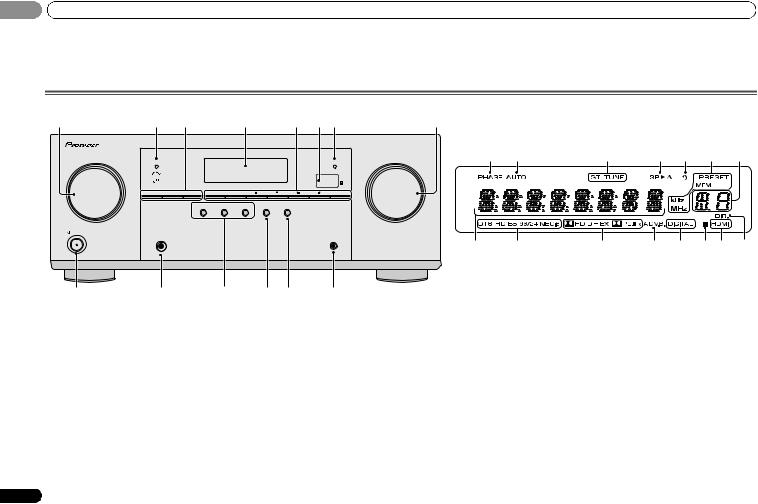
01 Controls and displays
Chapter 1:
Controls and displays
Front panel |
|
|
|
|
|
|
|
|
|
|
|
|
|
|
|
1 |
2 |
3 |
|
4 |
|
5 |
6 |
7 |
8 |
|
|
|
|
|
|
|
|
|
|
|
|
|
|
|
AUD O/ V DEO MULTICHANNEL RECE VER VSX 521 |
|
|
|
|
|
|
|
MCACC |
|
|
|
|
|
|
HDMI |
15 |
16 |
17 |
18 |
19 |
17 |
20 |
|
|
|
|
|
|
|
|
|
|
|
|
|
|
||
|
SPEAKERS DIMMER |
D SPLAY BAND |
TUNER ED T |
TUNE |
|
PRESET |
ENTER |
|
|
|
|
|
|
|
|
|
|
AUTO SURROUND/ |
ALC/ |
ADVANCED |
SOUND |
SOUND |
|
|
|
|
|
|
|
|
|
|
|
STREAM DIRECT STANDARD SURR |
SURROUND |
RETR EVER AIR |
RETR EVER |
|
|
|
|
|
|
|
|
|
|
NPUT |
|
|
|
|
|
|
|
|
MASTER |
|
|
|
|
|
|
SELECTOR |
|
|
|
|
|
|
|
|
VOLUME |
|
|
|
|
|
|
STANDBY/ON |
|
|
|
|
|
|
|
|
|
|
|
|
|
|
|
|
PHONES |
|
|
|
|
|
|
PORTABLE / |
|
|
|
|
|
|
|
|
|
|
|
|
|
|
MCACC SETUP M C |
21 |
22 |
23 |
24 |
25 |
26 25 |
27 |
|
|
|
|
|
|
|
|
|
|
|||||||
9 |
10 |
11 |
12 |
13 |
14 |
1 INPUT SELECTOR dial
Selects an input source (page 21).
2 MCACC indicator
Lights when Acoustic Calibration EQ (page 26) is on (Acoustic Calibration EQ is automatically set to on after the Auto MCACC setup (page 19)).
3Receiver control buttons
SPEAKERS – Use to change the speaker system on or off. When the SP OFF is selected, no sound is output from the speakers connected to this receiver.
DIMMER – Dims or brightens the display. The brightness can be controlled in four steps.
DISPLAY – Switches the display of this unit. The listening mode, sound volume, Pre Out setting or input name can be checked by selecting an input source.
•The Pre Out setting may or may not be displayed, depending on the input source you have selected.
6
4Character display
See Display on page 7.
5Tuner control buttons
BAND – Switches between AM, FM ST (stereo) and FM MONO radio bands (page 24).
TUNER EDIT – Use with TUNE /, PRESET / and
ENTER to memorize and name stations for recall (page 24).
TUNE / – Used to find radio frequencies (page 24). PRESET / – Use to select preset radio stations (page 24).
6Remote sensor
Receives the signals from the remote control (see Operating range of remote control on page 9).
7 HDMI indicator
Blinks when connecting an HDMI-equipped component; lights when the component is connected (page 14).
8MASTER VOLUME dial
9STANDBY/ON
10PHONES jack
Use to connect headphones. When the headphones are connected, there is no sound output from the speakers. The listening mode when the sound is heard from the headphone can be selected only from PHONES SURR, STEREO or STEREO ALC mode (S.R AIR mode can be also selected with
ADAPTER input).
11Listening mode buttons
AUTO SURROUND/STREAM DIRECT – Switches between Auto surround mode (page 25) and Stream Direct playback (page 26).
En

Controls and displays |
0101 |
ALC/STANDARD SURR – Press for standard decoding and to switch between the modes of 2Pro Logic II, 2 Pro Logic IIx, 2Pro Logic IIz and NEO:6, and the Auto level control stereo mode (page 25).
ADVANCED SURROUND – Switches between the various surround modes (page 26).
12 SOUND RETRIEVER AIR
When the button is pressed, the input switches to ADAPTER and the listening mode is automatically set to S.R AIR (page 23).
13 SOUND RETRIEVER
Press to restore CD quality sound to compressed audio sources (page 26).
14 PORTABLE/MCACC SETUP MIC jack
Use to connect an auxiliary component using a stereo minijack cable (page 18) or connect a microphone when performing Auto MCACC setup (page 19).
Display
15 PHASE
Lights when the Phase Control is switched on (page 27).
16 AUTO
Lights when the Auto Surround feature is switched on (page 25).
17Tuner indicators
ST – Lights when a stereo FM broadcast is being received in auto stereo mode (page 24).
TUNE – Lights when a normal broadcast channel.
PRESET – Shows when a preset radio station is registered or called.
MEM – Blinks when a radio station is registered.
kHz/MHz – Lights when the character display is showing the currently received AM/FM broadcast frequency.
18Speaker indicators
Shows if the speaker system is on or not (page 6). SP A means the speakers are switched on.
SP means the speakers are switched off.
19 Sleep timer indicator
Lights when the receiver is in sleep mode (page 8).
20PRESET information or input signal indicator
Shows the preset number of the tuner or the input signal type, etc.
21Character display
Displays various system information.
22DTS indicators
DTS – Lights when a source with DTS encoded audio signals is detected.
HD – Lights when a source with DTS-EXPRESS or DTSHD encoded audio signals is detected.
ES – Lights to indicate DTS-ES decoding.
96/24 – Lights when a source with DTS 96/24 encoded audio signals is detected.
NEO:6 – When one of the NEO:6 modes of the receiver is on, this lights to indicate NEO:6 processing (page 25).
23Dolby Digital indicators
2D – Lights when a Dolby Digital encoded signal is detected.
2D+ – Lights when a source with Dolby Digital Plus encoded audio signals is detected.
2HD – Lights when a source with Dolby TrueHD encoded audio signals is detected.
EX – Lights to indicate Dolby Digital EX decoding.
2PLII(x) – Lights to indicate 2Pro Logic II/2Pro Logic IIx decoding. Light will go off during 2Pro Logic IIz decoding (see Listening in surround sound on page 25 for more on this).
24ADV.S.
Lights when one of the Advanced Surround modes has been selected (see Using the Advanced surround on page 26 for more on this).
25SIGNAL SELECT indicators
DIGITAL – Lights when a digital audio signal is selected. Blinks when a digital audio signal is selected and selected audio input is not provided.
HDMI – Lights when an HDMI signal is selected. Blinks when an HDMI signal is selected and selected HDMI input is not provided.
26 Up Mix/DIMMER indicator
Lights when the Up Mix function is set to ON (page 27). Also, lights when DIMMER is set to off.
27 DIR.
Lights when the DIRECT or PURE DIRECT mode is switched on (page 26).
English
7
En
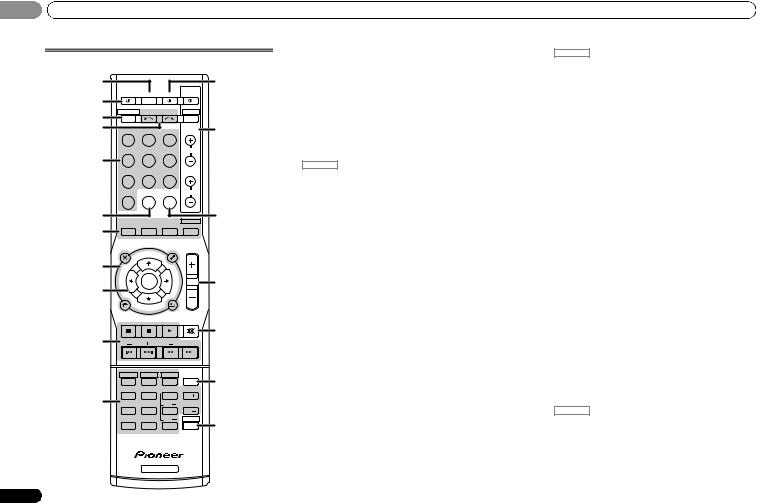
01 Controls and displays
Remote control
1 |
|
|
|
12 |
|
RECEIVER |
SLEEP |
SOURCE |
TV |
2 |
CONTROL |
|||
|
|
|
|
|
3 |
RECE VER |
INPUT SELECT |
DTV/TV |
|
|
|
|
INPUT |
|
4 |
BD |
DVD |
TV |
13 |
|
DVR/BDR |
CD |
CD R |
CH |
5 |
|
|||
|
|
|
|
|
|
ADAPTER |
TUNER |
PORTABLE |
|
|
VIDEO S RETR EVER |
S GNAL SEL |
VOL |
|
6 |
AUTO/ |
|
ALC/ |
BD MENU |
14 |
7 |
D RECT |
STEREO |
STANDARD |
ADV SURR |
|
|
|
|
|
|
|
|
AUD O |
|
TUNER EDIT |
MASTER |
|
|
PARAMETER |
|
TOOLS |
VOLUME |
|
|
TOP |
TUNE |
MENU |
|
|
|
|
|
|
||
8 |
MENU |
|
|
|
|
|
T |
|
P |
|
|
|
E |
|
R |
|
15 |
|
S |
ENTER |
E |
|
|
|
E |
S |
|
||
9 |
R |
|
E |
|
|
P |
|
|
|||
|
|
T |
|
|
|
|
|
|
|
|
|
|
HOME |
|
|
|
|
|
MENU |
TUNE |
BAND |
|
|
|
SETUP |
|
|
||
|
|
RETURN |
|
|
|
|
|
|
|
MUTE |
16 |
10 |
|
|
|
|
|
BASS |
TRE |
|
|||
|
HDD |
DVD |
VCR |
|
17 |
|
1 |
2 |
3 |
DISP |
|
|
|
SB CH |
CH SELECT |
EQ |
|
11 |
4 |
5 |
6 |
CH |
|
MIDNIGHT SPEAKERS |
LEV |
PHASE |
|
||
|
7 |
8 |
9 |
CH |
|
|
DIMMER |
0 |
LEV |
SHIFT |
18 |
|
CLR |
ENTER |
|
||
|
+10 |
|
|
|
|
|
|
RECEIVER |
|
|
|
8
As for operating other devices, the remote control codes for the Pioneer products are preset. The settings cannot be changed.
1 SLEEP
Press to change the amount of time before the receiver switches into standby (30 min – 60 min – 90 min – Off). You can check the remaining sleep time at any time by pressing
SLEEP once.
2 RECEIVER
Switches the receiver between standby and on.
3 RECEIVER
Switches the remote to control the receiver (used to select the white commands above the number buttons (MIDNIGHT, etc)). Also use this button to set up surround sound (page 30) or Audio parameters (page 28).
4 INPUT SELECT 
Use to select the input source (page 21).
5 Input function buttons
Use to select the input source to this receiver (page 21). This will enable you to control other Pioneer components with the remote control.
6 S.RETRIEVER
Press to restore CD quality sound to compressed audio sources (page 26).
7Listening mode buttons
AUTO/DIRECT – Switches between Auto surround mode (page 25) and Stream Direct playback (page 26).
STEREO – Press to select stereo playback (page 25).
ALC/STANDARD SURR – Press for standard decoding and to switch between the modes of 2Pro Logic II, 2 Pro Logic IIx, 2Pro Logic IIz and NEO:6, and the Auto level control stereo mode (page 25).
ADV SURR – Switches between the various surround modes (page 26).
Press BD first to access:
BD MENU* – Displays the disc menu of Blu-ray Discs.
8 System Setup and component control buttons
The following button controls can be accessed after you have selected the corresponding input function button (BD, DVD, etc.).
Press RECEIVER first to access:
AUDIO PARAMETER – Use to access the Audio options (page 28).
SETUP – Press to access the System Setup menu (page 30).
RETURN – Confirm and exit the current menu screen. Press BD, DVD or DVR/BDR first to access:
TOP MENU – Displays the disc ‘top’ menu of a Blu-ray Disc/DVD.
HOME MENU – Displays the HOME MENU screen. RETURN – Confirm and exit the current menu screen.
MENU – Displays the TOOLS menu of Blu-ray Disc player. Press TUNER first to access:
TUNER EDIT – Memorizes stations for recall (page 24), also used to change the name (page 24).
BAND – Switches between AM, FM ST (stereo) and FM MONO radio bands (page 24).
9 / / / (TUNE /, PRESET /), ENTER
Use the arrow buttons when setting up your surround sound system (page 30). Also used to control Blu-ray Disc/DVD menus/options.
Use TUNE / can be used to find radio frequencies and PRESET / can be used to select preset radio stations (page 24).
10 Component control buttons
The main buttons ( , , etc.) are used to control a component after you have selected it using the input function buttons.
The controls above these buttons can be accessed after you have selected the corresponding input function button (BD, DVD, DVR/BDR and CD). These buttons also function as described below.
Press RECEIVER first to access:
BASS –/+, TRE –/+ – Use to adjust Bass or Treble.
•These controls are disabled when the listening mode is set to DIRECT or PURE DIRECT.
En
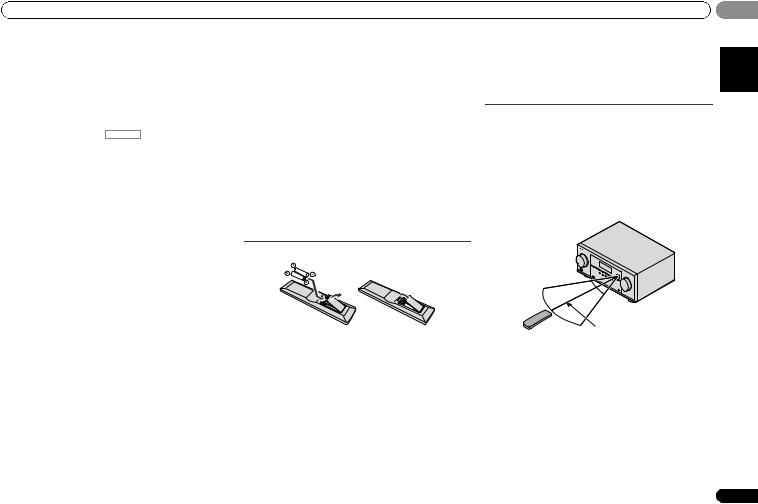
Controls and displays |
0101 |
•When the front speaker is set at SMALL in the Speaker Setting (or automatically via the Auto MCACC setup) and the Crossover Network is set above 150 Hz, the subwoofer channel level will be adjusted by pressing BASS –/+ (page 31).
11 Number buttons and other component controls
Use the number buttons to directly select a radio frequency (page 24) or the tracks on a CD, etc. There are other buttons that can be accessed after RECEIVER is pressed. (For example MIDNIGHT, etc.)
HDD*, DVD*, VCR* – These buttons switch between the hard disk, DVD and VCR controls for HDD/DVD/VCR recorders.
SB CH – Press to select ON, AUTO or OFF the surround back channel (page 27).
CH SELECT – Press repeatedly to select a channel, then use LEV +/– to adjust the level (page 31).
LEV +/– – Use to adjust the channel level.
EQ – Press to switch on/off Acoustic Calibration EQ setting (page 26).
MIDNIGHT – Switches to Midnight or Loudness listening (page 28).
SPEAKERS – Use to change the speaker system on or off. When the SP OFF is selected, no sound is output from the speakers connected to this receiver.
PHASE – Press to switch on/off Phase Control (page 27).
DIMMER – Dims or brightens the display. The brightness can be controlled in four steps.
12 SOURCE
Turns on or off the power of the Pioneer DVD/DVR units when BD, DVD, DVR/BDR or CD is selected using the input function buttons.
13 TV CONTROL buttons
These buttons can control only be used with Pioneer TVs.– Use to turn on/off the power of the TV.
INPUT – Use to select the TV input signal.
CH +/– – Use to select channels.
VOL +/– – Use to adjust the volume on your TV.
DTV/TV* – Switches between the DTV and analog TV input modes for Pioneer TVs.
14 SIGNAL SEL
Press to select the audio input signal of the component to play back (page 21).
15 MASTER VOLUME +/–
Use to set the listening volume.
16 MUTE
Mutes/unmutes the sound.
17 DISP
Switches the display of this unit. The listening mode, sound volume, Pre Out setting or input name can be checked by selecting an input source.
•The Pre Out setting may or may not be displayed, depending on the input source you have selected.
18 SHIFT
Press to access the ‘boxed’ commands (above the buttons) on the remote. These buttons are marked with an asterisk (*) in this section.
Loading the batteries
-Do not use or store batteries in direct sunlight or other excessively hot place, such as inside a car or near a heater. This can cause batteries to leak, overheat, explode or catch fire. It can also reduce the life or performance of batteries.
Operating range of remote control
The remote control may not work properly if:
•There are obstacles between the remote control and the receiver’s remote sensor.
•Direct sunlight or fluorescent light is shining onto the remote sensor.
•The receiver is located near a device that is emitting infrared rays.
•The receiver is operated simultaneously with another infrared remote control unit.
30°  30°
30°
English
The batteries included with the unit are to check initial operations; they may not last over a long period. We recommend using alkaline batteries that have a longer life.
 CAUTION
CAUTION
•Incorrect use of batteries may result in such hazards as leakage and bursting. Observe the following precautions:
-Never use new and old batteries together.
-Insert the plus and minus sides of the batteries properly according to the marks in the battery case.
-Batteries with the same shape may have different voltages. Do not use different batteries together.
-When disposing of used batteries, please comply with governmental regulations or environmental public instruction’s rules that apply in your country or area.
7 m (23 ft.)
9
En
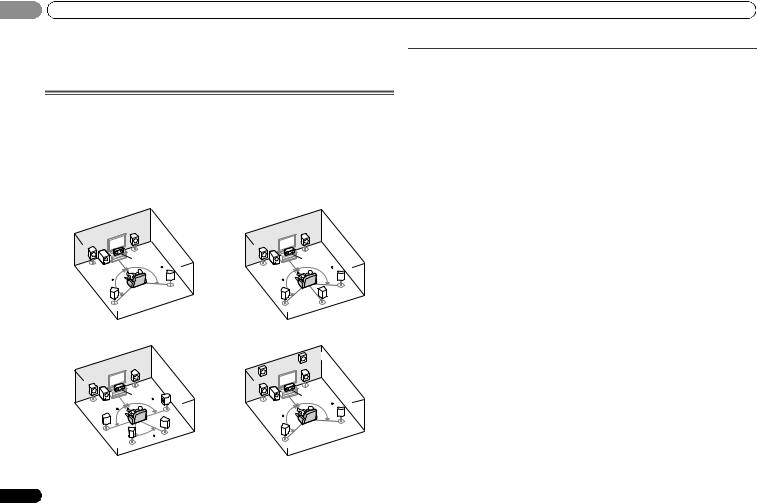
02 Connecting your equipment
Chapter 2:
Connecting your equipment
Placing the speakers
By connecting the left and right front speakers (L/R), the center speaker (C), the left and right surround speakers (SL/SR), and the subwoofer (SW), a 5.1 ch surround system can be enjoyed. Further, by using an external amplifier, you can connect the left and right surround back speakers (SBL/SBR) or the left and right front height speaker (FHL/FHR) to boost your system up to a 7.1 ch surround system.
• You can also connect one surround back speaker (SB) and enjoy a 6.1 ch surround system. To achieve the best possible surround sound, install your speakers as shown below.
5.1 channel surround system: |
6.1 channel surround |
||||
|
|
|
(Surround back) system: a |
||
|
R |
|
|
|
R |
L |
|
|
L |
|
|
|
C |
|
|
|
C |
SW |
120 |
|
SW |
|
120 |
120 |
|
|
120 |
|
|
|
|
SR |
|
|
SR |
SL |
|
|
|
SL |
SB |
|
|
|
|
||
7.1 channel surround |
|
7.1 channel surround |
|||
(Surround back) system: a |
(Front height) system: a |
||||
|
|
|
|
|
FHR |
|
R |
|
FHL |
|
|
|
|
|
|
R |
|
L |
|
|
|
|
|
|
|
|
|
|
|
|
C |
|
L |
|
C |
|
SR |
|
|
||
|
90 |
|
|
|
|
SW |
|
SW |
|
120 |
|
|
|
|
|||
90 |
|
|
|
|
|
|
|
|
120 |
|
|
SL |
|
SBR |
|
|
SR |
60 |
|
|
|
|
|
SBL |
|
|
SL |
|
|
|
|
|
|
||
a.This layout is available only when the additional amplifier is connected to the unit and the surround back or front height speakers are connected to the amplifier. For details, see Connect the surround back or front height speakers on page 11.
10
Hints on the speaker placement
Where you put your speakers in the room has a big effect on the quality of the sound. The following guidelines should help you to get the best sound from your system.
•The subwoofer can be placed on the floor. Ideally, the other speakers should be at about ear-level when you’re listening to them. Putting the speakers on the floor (except the subwoofer), or mounting them very high on a wall is not recommended.
•For the best stereo effect, place the front speakers 2 m to 3 m (6 ft. to 9 ft.) apart, at equal distance from the TV.
•If you’re going to place speakers around your CRT TV, use shielded speakers or place the speakers at a sufficient distance from your CRT TV.
•If you’re using a center speaker, place the front speakers at a wider angle. If not, place them at a narrower angle.
•Place the center speaker above or below the TV so that the sound of the center channel is localized at the TV screen. Also, make sure the center speaker does not cross the line formed by the leading edge of the front left and right speakers.
•It is best to angle the speakers towards the listening position. The angle depends on the size of the room. Use less of an angle for bigger rooms.
•Surround and surround back speakers should be positioned 60 cm to 90 cm (2 ft. to 3 ft.) higher than your ears and titled slight downward. Make sure the speakers don’t face each other. For DVD-Audio, the speakers should be more directly behind the listener than for home theater playback.
•If the surround speakers cannot be set directly to the side of the listening position with a 7.1-channel system, the surround effect can be enhanced by turning off the Up Mix function (see Setting the Up Mix function on page 27).
•Try not to place the surround speakers farther away from the listening position than the front and center speakers. Doing so can weaken the surround sound effect.
•Place the left and right front height speakers at least one meter directly above the left and right front speakers.
 CAUTION
CAUTION
•Make sure that all speakers are securely installed. This not only improves sound quality, but also reduces the risk of damage or injury resulting from speakers being knocked over or falling in the event of external shocks such as earthquakes.
 Important
Important
•To connect the surround back or front height speakers, an additional amplifier is required. Connect the additional amplifier to the PRE OUT SURR BACK/FRONT HEIGHT outputs of this unit and connect the surround back or front height speakers to the additional amplifier (see Connect the surround back or front height speakers on page 11).
En
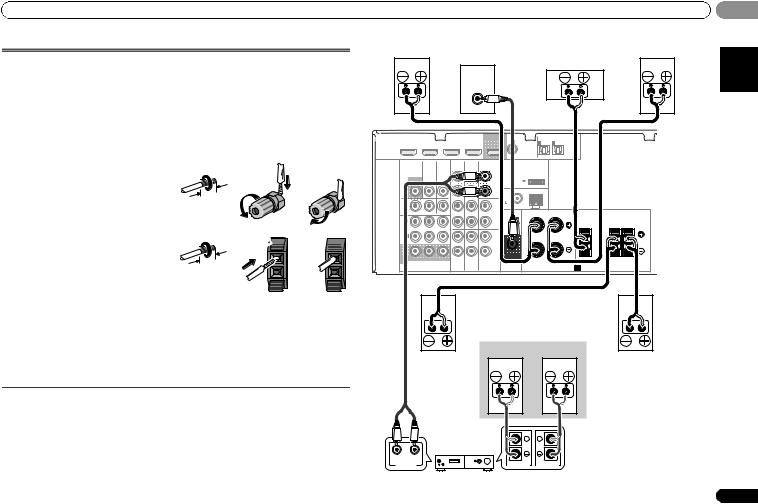
Connecting your equipment
Connecting the speakers
The receiver will work with just two stereo speakers (the front speakers in the diagram) but using at least three speakers is recommended, and a complete setup is best for surround sound.
Make sure you connect the speaker on the right to the right (R) terminal and the speaker on the left to the left (L) terminal. Also make sure the positive and negative (+/–) terminals on the receiver match those on the speakers.
Be sure to complete all connections before connecting this unit to the AC power source.
Bare wire connections
Front speaker terminals: |
1 |
|
1Twist exposed wire strands together.
2Loosen terminal and insert exposed wire.
3Tighten terminal.
Center and surround speaker terminals: |
1 |
|
1Twist exposed wire strands together.
2Push open the tabs and insert exposed wire.
3Release the tabs.
2 3
10 mm (3/8 in.)
2 
 3
3 


10 mm (3/8 in.)
 CAUTION
CAUTION
•These speaker terminals carry HAZARDOUS LIVE voltage. To prevent the risk of electric shock when connecting or disconnecting the speaker cables, disconnect the power cord before touching any uninsulated parts.
•Make sure that all the bare speaker wire is twisted together and inserted fully into the speaker terminal. If any of the bare speaker wire touches the back panel it may cause the power to cut off as a safety measure.
Connect the surround back or front height speakers
Connect the PRE OUT SURR BACK/FRONT HEIGHT outputs of the unit and additional amplifier to add a surround back or front height speaker.
•The Pre Out setting must be set if the above connections are performed. Select SURR.BACK if the surround back speaker is connected and HEIGHT if the front height speaker is connected (If neither the surround back speaker nor the front height speaker is connected, either setting will suffice) (see The Pre Out Setting on page 33).
•You can use the additional amplifier on the surround back channel pre-outs for a single speaker as well. In this case plug the amplifier into the left (L (Single)) terminal only.
Front right |
Subwoofer |
|
|
Front left |
||
|
|
|
Center |
|||
|
|
|
|
|
|
|
|
|
LINE LEVEL |
|
|
|
|
|
|
INPUT |
|
|
|
|
HDMI DVR/BDR IN DVD IN |
BD IN |
VIDEO N |
OUT CO XIAL |
IN |
N |
OPTIC L |
|
|
|
IN |
1 |
2 |
ASSIGNA |
|
|
|
ASS GNABLE |
|
|
|
|
|
|
(C ) |
(TV SAT) CD R TAPE) |
||
VIDEO |
AUDIO |
SURR BACK/ |
|
|
|
|
|
DVR/BDR CD R/TAPE FRONT HEIGHT |
|
|
|
||
|
MONITOR TV SAT |
BD |
|
|
L |
|
ADAPTER PORT |
|
|
|
|
|
|
|
Singl ) |
OUTP |
5 V |
|
|
|
|||
|
|
|
|
OUT |
|
PRE OUT |
0 1 A |
AX) |
|
|
|
|
|
|
|
|
|
R |
M |
ANTENNA |
|
|
|
|
|
|
|
|
|
|
|
|
|
|
|
D R/ |
|
|
|
|
CD |
UNBAL |
|
|
|
|
|
B R |
|
|
|
|
L |
5 |
|
|
|
|
|
|
|
|
|
|
AM LOOP |
|
|
|
|||
|
|
|
|
|
|
|
|
|
|
|
|
|
OUT |
N |
DVD N |
IN |
|
N |
|
R FRONT |
L |
|
|
I |
|
|
|
|
|
R |
|
|
CENTER |
SURROUND |
|
D D |
|
|
|
|
|
|
|
|
R |
L |
|
A |
GNABLE |
|
|
|
|
|
|
|
|
|
|
I |
|
|
|
|
|
L |
|
|
|
|
|
D R/ |
|
|
|
|
|
|
|
|
|
|
|
B R) |
|
|
IN |
|
N |
|
|
|
|
|
|
|
|
|
|
|
|
R |
|
|
|
|
|
M |
TOR |
|
|
|
|
|
SUBWOOFER |
|
|
|
|
O |
Y |
PB |
PR |
TV/SAT |
BD |
DVD |
|
|
|
|
|
COMPONENT VIDEO |
PRE OUT Cla s 2 Wiring |
SPEAKERS A |
Surround right Surround left
Surround back or front height speakers
Right Left
R ANALOG L |
SPEAKER R |
SPEAKER L |
|
AUDIO IN |
|||
|
|
Surround back or front height channel amplifier
0202
English
11
En
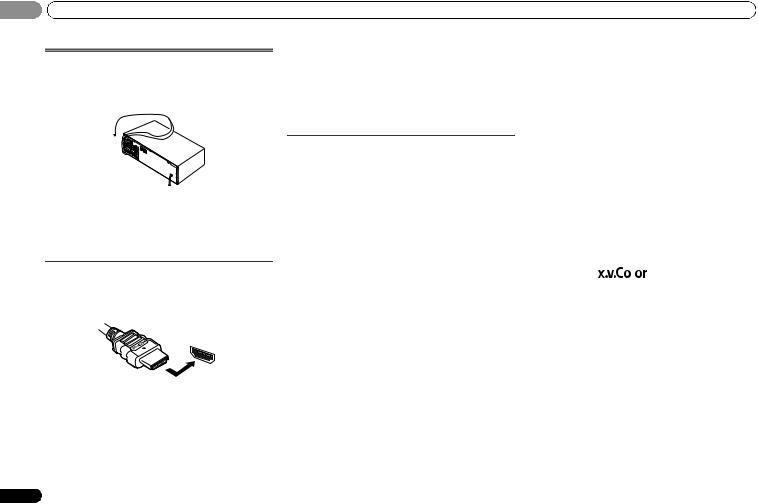
02 Connecting your equipment
Making cable connections
Make sure not to bend the cables over the top of this unit (as shown in the illustration). If this happens, the magnetic field produced by the transformers in this unit may cause a humming noise from the speakers.
 Important
Important
•Before making or changing connections, switch off the power and disconnect the power cord from the AC outlet.
•Before unplugging the power cord, switch the power into standby.
HDMI cables
Both video and sound signals can be transmitted simultaneously with one cable. If connecting the player and the TV via this receiver, for both connections, use HDMI cables.
HDMI
Be careful to connect the terminal in the proper direction.
 Note
Note
•Set the HDMI parameter in Setting the Audio options on page 28 to THRU (THROUGH) and set the input signal in
Selecting the audio input signal on page 21 to HDMI, if you want to hear HDMI audio output from your TV (no sound will be heard from this receiver).
•If the video signal does not appear on your TV, try adjusting the resolution settings on your component or display. Note that some components (such as video game units) have resolutions that may not be displayed. In this case, use a (analog) composite connection.
•When the video signal from the HDMI is 480i, 480p, 576i or 576p, Multi Ch PCM sound and HD sound cannot be received.
About HDMI
The HDMI connection transfers uncompressed digital video, as well as almost every kind of digital audio that the connected component is compatible with, including DVDVideo, DVD-Audio, SACD, Dolby Digital Plus, Dolby TrueHD, DTS-HD Master Audio (see below for limitations), Video CD/ Super VCD and CD.
This receiver incorporates High-Definition Multimedia Interface (HDMI®) technology.
This receiver supports the functions described below through HDMI connections.
•Digital transfer of uncompressed video (contents protected by HDCP (1080p/24, 1080p/60, etc.))
•3D signal transfer
•Deep Color signal transfer
•x.v.Color signal transfer
•Audio Return Channel
•Input of multi-channel linear PCM digital audio signals (192 kHz or less) for up to 8 channels
•Input of the following digital audio formats:
– Dolby Digital, Dolby Digital Plus, DTS, High bitrate audio (Dolby TrueHD, DTS-HD Master Audio), DVDAudio, CD, SACD (DSD 2 ch only), Video CD, Super VCD
•Synchronized operation with components using the Control with HDMI function (see Control with HDMI function on page 34)
12
 Note
Note
•Use a High Speed HDMI® cable. If HDMI cable other than a High Speed HDMI® cable is used, it may not work properly.
•When an HDMI cable with a built-in equalizer is connected, it may not operate properly.
•3D, Deep Color, x.v.Color signal transfer and Audio Return Channel are only possible when connected to a compatible component.
•HDMI format digital audio transmissions require a longer time to be recognized. Due to this, interruption in the audio may occur when switching between audio formats or beginning playback.
•Turning on/off the device connected to this unit’s HDMI OUT terminal during playback, or disconnecting/ connecting the HDMI cable during playback, may cause noise or interrupted audio.
HDMI, the HDMI Logo and High-Definition Multimedia Interface are trademarks or registered trademarks of HDMI Licensing, LLC in the United States and other countries.
“x.v.Color” and |
are trademarks of Sony |
Corporation.
En
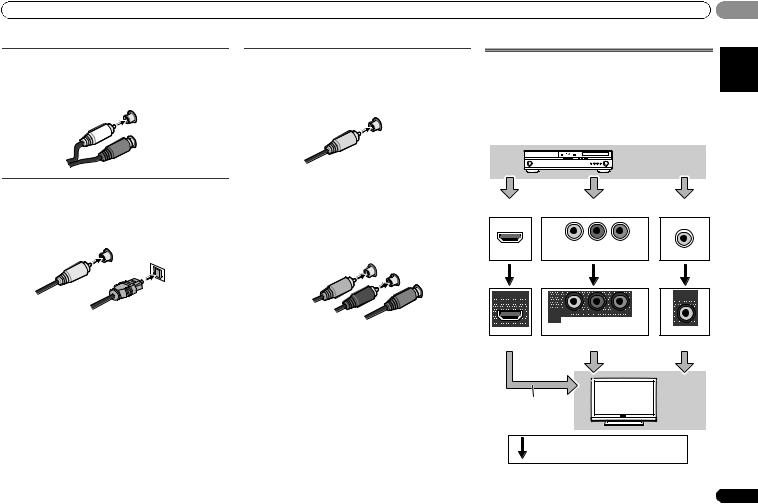
Connecting your equipment |
0202 |
Analog audio cables
Use stereo RCA phono cables to connect analog audio components. These cables are typically red and white, and you should connect the red plugs to R (right) terminals and white plugs to L (left) terminals.
White (Left)
L |
|
R |
AUDIO |
|
Red (Right)
Digital audio cables
Commercially available coaxial digital audio cables or optical cables should be used to connect digital components to this receiver.
Coaxial digital |
COAXIAL |
|
IN |
OPTICAL |
|
audio cable |
|
|
|
|
|
|
|
IN |
|
|
Optical cable |
 Note
Note
•When connecting optical cables, be careful when inserting the plug not to damage the shutter protecting the optical socket.
•When storing optical cable, coil loosely. The cable may be damaged if bent around sharp corners.
•You can also use a standard RCA video cable for coaxial
digital connections.
Video cables
Standard RCA video cables
These cables are the most common type of video connection and are used to connect to the composite video terminals. The yellow plugs distinguish them from cables for audio.
VIDEO
Yellow
Component video cables
Use component video cables to get the best possible color reproduction of your video source. The color signal of the TV is divided into the luminance (Y) signal and the color (PB and PR) signals and then output. In this way, interference between the signals is avoided.
|
COMPONENT |
|
|
Y |
VIDEO |
|
PB |
|
Green (Y) |
|
PR |
|
|
|
Blue (PB) |
Red (PR) |
|
About video outputs connection
This receiver is not loaded with a video converter. When you use component video cables or HDMI cables for connecting to the input device, the same cables should be used for connecting to the TV.
The signals input from the analog (composite and component) video inputs of this unit will not be output from the HDMI OUT.
Playback component
Terminal for connection with source device
IN |
IN |
|
IN |
|
|
|
|
HDMI |
Y |
PB PR |
|
COMPONENT VIDEO |
VIDEO |
||
OUT |
|
|
MONITOR |
|
|
OUT |
|
|
|
|
|
|
MONITOR |
|
|
|
OUT Y |
PB PR |
|
HDMI |
COMPONENT VIDEO |
VIDEO |
|
Terminal for connection with TV monitor
The OSD will
not appear.
TV
Video signals can be output.
English
13
En
